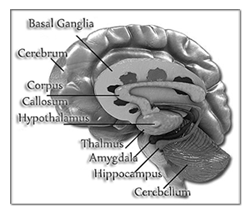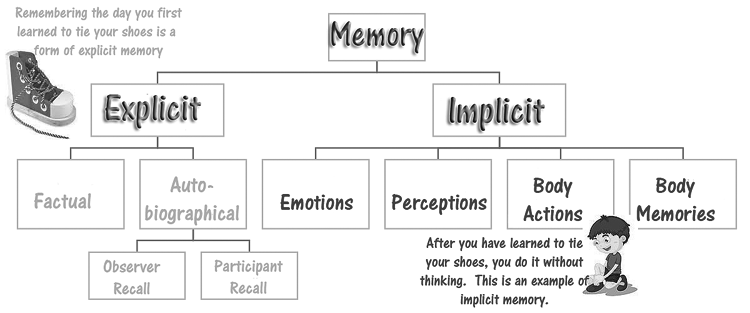Unprocessed trauma and stored memory, both implicit and explicit types
Trauma that has yet to be processed will remain in the mind, and is not the same as a processed memory. Therefore to avoid confusion, this site will not refer to it as memory. A trauma that has not been processed behaves as a live remembrance of an event, rather than a re-callable memory. There are several precursors to this malfunction between the mind and the hippocampus of the brain where memory is normally stored. If a child were unable to obtain a secure attachment with their primary caregiver then through a complicated series of processes the trauma event will stay in the mind until an individual's hippocampus is able to read a signal that the trauma events needs to be processed.
Memory, on the other hand, is an active set of events that occurred that were correctly processed in the hippocampus of the brain. Recalling a memory is not as simple as bringing forth details stored from the past. [1]:51 Past events are what shapes and influences the way an individual feels and acts in the future, even though that individual may not consciously recall the event they are reacting to. The recall of past events determines which components of the brain will activate in the future.

Memory has three important elements: 1). past, 2). influence of the future, and 3.) shaping reaction in the future. [1]:46-90 The associational process is what scientists call the linking together events that occur simultaneously. In fact, a good description of memory is the linking of simultaneous events. When events link, then it is easier to recall the linked events together. [1]:46-51
- Encoding (laying down) of memory
There are two layers of memory that are laid down throughout life: implicit memory(Mental models, behaviors, images and emotions). Implicit memory involves parts of the brain that do not require conscious processing during encoding or retrieval." This form of memory is available in infancy and, when retrieved, it is not thought to carry an internal sensation that something is being recalled." {{Rp|51}}Implicit memory is the first layer of encoded memory to be laid down. The encoding literally shapes a child's architecture of the Self. {{Rp|55}}At 18 months old, the hippocampus develops and this region of the brain matures and begins to integrate the building blocks of implicit memory together to form explicit memory.■ Earliest form of memory.■ Devoid of the subjective internal experience of "recalling," of self, or time.■ Involves mental models and "priming."■ Focal attention is not required for encoding.■ Mediated via brain circuits involved in the initial encoding and independent of the medial temporal lobe/hippocampus. {{Rp|57}} and explicit memory(Facts, events and autobiographical consciousness). Explicit Memory is the second layer of encoded memory to be laid down. Both factual and autobiographical memory develop after 18 months of age. The narrative process is one way that the mind attempts to integrate."As a child develops, the mind begins to create a sense of continuity across time, linking past experiences with present perceptions and anticipations of the future. Within these representational processes, generalizations or mental models of the self (see self) and the Self with others are created; these form an essential scaffold for the minds growing interactions with the world." {{Rp|11}} It is late memory - present beginning in the first year of life.■ Semantic : Factual memory. Initial development by one or two years of age.■ Autobiographical : Collections of episodic memory. Progressive development with onset after second year of life.■ Requires conscious awareness for encoding and having the subjective sense of recollection (and, if autobiographical, of self and time).■ Focal attention required for encoding.■ Hippocampal processing required for storage and initial retrieval. Cortical consolidation makes selected events a part of permanent memory and independent of hippocampal involvement for retrieval. {{Rp|57}}. Implicit memory is the first layer of encoded memory, which appears to be present before birth, so of course it is also there during early infancy. This layer of memory involves the part of the brain that does not need conscious attention for encoding (process of laying down of memory). [1]:46-52 [2]
- Storing memory
After memory has been laid down it is then stored, but the term storing can be misleading, since the memory is not stored as a whole or even as a thing. Instead, scientists believe that memory is "the change in probability of activating a particular neural network pattern in the future." [1]:48 In other words, the brain has the ability to reactivate visual circuitry that was similar to the initial encoding of memory. [1]:48
- Memory retrieval
Humans can retrieve what was stored, some can do this better than others, but the process is not straight forward. Stored events are recalled along with associated aspects of stored memory. The associational linkages make it more likely that items will be activated simultaneously during the retrieval process. [1]:48
- Implicit memory
As soon as a baby is born they can perceive their environment, and they already have the ability to recall experiences in the form of implicit memory. Remember that implicit memory involves the parts of the brain that do not require conscious processing during encoding or retrieval. [1]:52 It involves the execution of routine operations, such as riding a bicycle or typing.[3]
-
Implicit memory has four elements:
- Emotions (fear, guilt, shame, happiness, etc...)
- Perceptions (Associating or linking a representation with a particular word.)
- Body response patterns (example: If your hand was burning, you would pull your hand away from the heat.)
- Body Memory/Sensation (This does not mean you have actual memory in your body. Example: Feeling pain in the hand today, that you burned a decade ago. [1]:51-56
Mental models (schema or generalization of repeated experience) are a process basic to implicit memory, used to anticipate future from past events. Example: If a young boy has burned his hand several times in the past while roasting marshmallows over a campfire, then he would make a generalization of the repeated experience. This is the mental model. The next time the boy goes camping and a campfire is built, he might feel the emotions he felt in the past when he burned his hand, and even experience the body action of pulling his hand away from the heat of the fire. He might begin to associate the words fire, burn, camping, marshmallow, etc... with fear or pain, which leads to a state of mind. The fire might even appear overwhelming, or out of control to him because the firing patterns in his brain have associated a campfire with pain and being burned. [1]:52-56
- * Priming
Priming is the act of getting ready to respond. For example, when the same boy described above, simply smells smoke from a distance he might react, even though he is not aware why. [1]:132-134
- * The developing self

- Explicit Memory(Facts, events and autobiographical consciousness). Explicit Memory is the second layer of encoded memory to be laid down. Both factual and autobiographical memory develop after 18 months of age. The narrative process is one way that the mind attempts to integrate."As a child develops, the mind begins to create a sense of continuity across time, linking past experiences with present perceptions and anticipations of the future. Within these representational processes, generalizations or mental models of the self (see self) and the Self with others are created; these form an essential scaffold for the minds growing interactions with the world." {{Rp|11}} It is late memory - present beginning in the first year of life.■ Semantic : Factual memory. Initial development by one or two years of age.■ Autobiographical : Collections of episodic memory. Progressive development with onset after second year of life.■ Requires conscious awareness for encoding and having the subjective sense of recollection (and, if autobiographical, of self and time).■ Focal attention required for encoding.■ Hippocampal processing required for storage and initial retrieval. Cortical consolidation makes selected events a part of permanent memory and independent of hippocampal involvement for retrieval. {{Rp|57}}
Explicit memories are available for immediate and conscious recall and include recollection of facts and experiences of which one is conscious, whereas implicit memories are independent of conscious memory." [4]
Explicit memory involves the recall of personal experience identified with the self (e.g., "I was camping last week"). "[3] There are two types of explicit memory: 1.) factual 2.) autobiographical. Unlike implicit memory, explicit memory requires that an individual be consciously aware and focused [2] for the laying down (encoding) of memory. [1]:57
- * Factual explicit memory (semantic)
This type of memory involves facts, and does not have a sense of self and time.
- * Autobiographical explicit memory (episodic)
Autobiographic memory has both a sense of self and a sense of time, involving recall of personal experience identifying with the self. [3]
-
-
- Autobiographical Recall
-
- Observer recall
- Participant recall
Emotion and memory
If the brain considers an event important, then it is more likely to be recalled in the future. Repeated and emotional events are easier to recall, while an overwhelming event might inhibit the hippocampal processing of explicit memories, encoding and retrieval. At the same time, dissociation and chemicals released by the amygdalya can be active in blocking explicit memory encoding. These actions appear to change the way that both implicit and explicit memory interact when an individual is subjected to trauma. [1]:72 The relationship between emotion, memory and self is complicated, but it seems to "suggests that emotionally arousing experiences are more readily recalled later on" [1]:73
- Memory loss
Dissociative amnesia, which is a loss of memory, is a symptom of many different trauma and/or Dissociative Disorders, including posttraumamatic stress disorder, other specified dissociative disorder and dissociative identity disorder. Dissociative amnesia can affect both implicit and explicit memory. [2]
Edit this site
We encourage those with knowledge of the trauma-stressor and dissociative disorders to join our project and help to create an accurate and helpful information based wiki. To do so, simply make an account and review our editor guidelines.Other branches of the Trauma and Dissociation Project
Dissociative Identity Disorder.org is a multi-authored peer written site, reviewed by a health care professional.
References
- ^ a b c d e f g h i j k l m n o p q r s Siegel, Daniel J.. . New York:Guilford Press. 146250390X.
- ^ a b c Lanius, R. (2010). The Impact of Early Life Trauma on Health and Disease: The Hidden Epidemic. 10: 0521880262.
- ^ a b c Hales, R. (2008). . 10: 1585622575.
- ^ Sharon, Idan, Roni Sharon, and Jaclyn P. Wilkens. "Dissociative disorders." (2009). http://emedicine.medscape.com/article/294508-overview
- Memory



